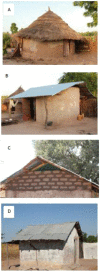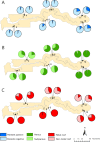Reduced mosquito survival in metal-roof houses may contribute to a decline in malaria transmission in sub-Saharan Africa
- PMID: 31123317
- PMCID: PMC6533302
- DOI: 10.1038/s41598-019-43816-0
Reduced mosquito survival in metal-roof houses may contribute to a decline in malaria transmission in sub-Saharan Africa
Abstract
In The Gambia, metal-roof houses were hotter during the day than thatched-roof houses. After 24 h, the mortality of Anopheles gambiae, the principal African malaria vector, was 38% higher in metal-roof houses than thatched ones. During the day, mosquitoes in metal-roof houses moved from the hot roof to cooler places near the floor, where the temperature was still high, reaching 35 °C. In laboratory studies, at 35 °C few mosquitoes survived 10 days, the minimum period required for malaria parasite development. Analysis of epidemiological data showed there was less malaria and lower vector survival rates in Gambian villages with a higher proportion of metal roofs. Our findings are consistent with the hypothesis that the indoor climate of metal-roof houses, with higher temperatures and lower humidity, reduces survivorship of indoor-resting mosquitoes and may have contributed to the observed reduction in malaria burden in parts of sub-Saharan Africa.
Conflict of interest statement
The authors declare no competing interests.
Figures




References
Publication types
MeSH terms
Grants and funding
LinkOut - more resources
Full Text Sources
Medical

